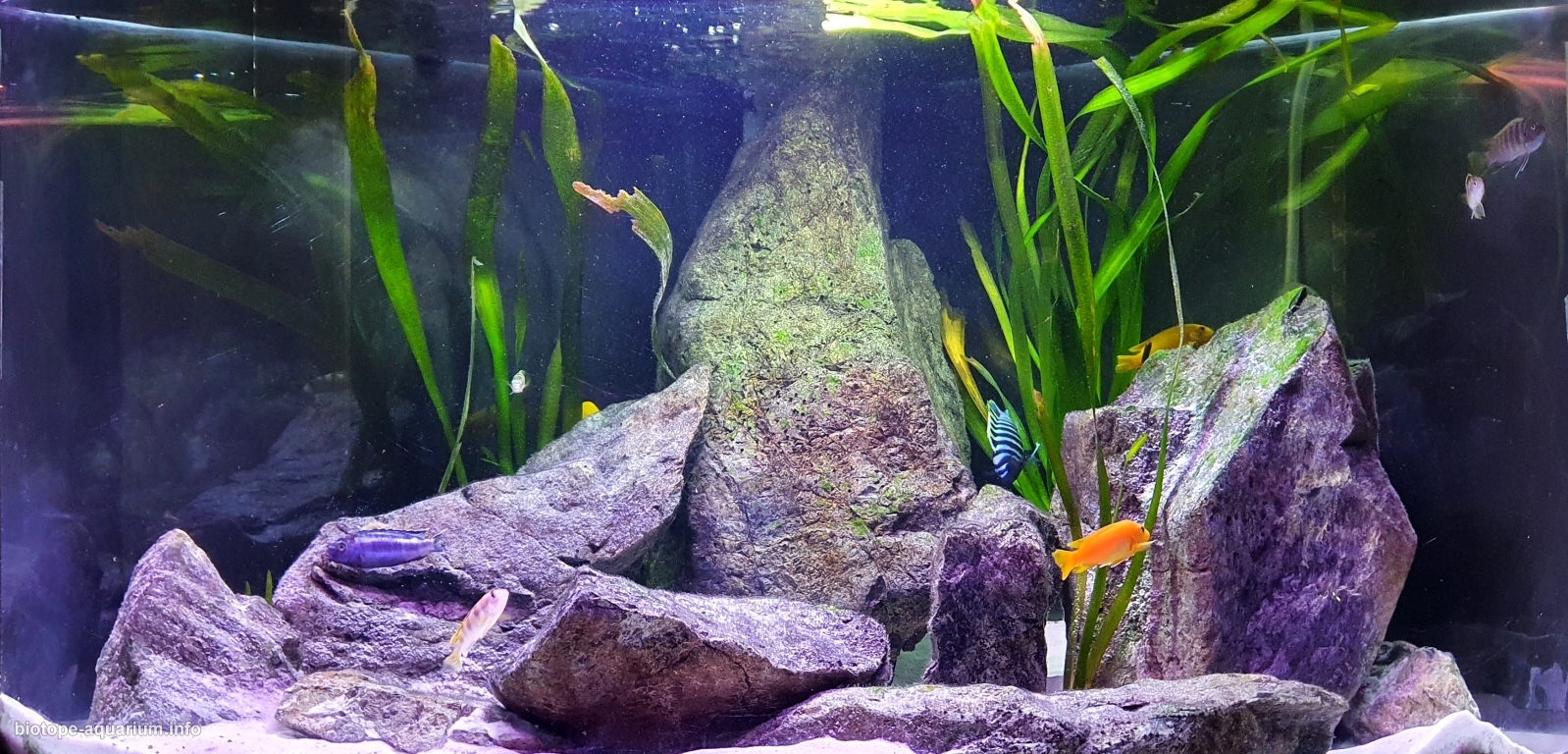The sandy areas towards the rock face
_th place in Biotope Aquarium Design Contest 2020

Volume: 190 L
Dimensions: 98,50x70x60
List of fishes: Cynotilapia Zebroides Red Top Likoma 1/1
Pseudotropheus johanii Gome 1/3
Labidochromis Perlmutt Highlanders Reef 1/3
List of plants: Vallisneria Gigantea
Description of decorations: The aquarium is built with real Alps green rocks , coming from the hills of Genoa . It is the sand used was clear end
Description of equipment: Technique :
Filtration : External filter Ascoli Pratiko 300
Cool system : Due to the high summer temperatures, I equipped the tank with 4 JEBO fans, managed by Haquoss Thermocontroll set at a temperature of 27 ° C
Heating N / A
Lighting system : self-built ceiling light with 3 LED bars IP67 from 30 cm to 12 V managed by the TC420 control unit for sunrise sunset effect for a total of 8 hours of light per day.
The bars used are cos ì constituted: LRTBW SMD 5730 12 V white light 6500K to 60% intensity à – LRTBW SMD 5730 12V light blue / white to 25% intensity à – LRTBW SMD 5730 12V Light White / Blue / Red 35 % intensity of a .
Water parameters: Chemistry : the temperature is 2 2 -2 7 ° C, pH 8.2 GH 1 3 , KH 1 0, NO2 0, NO3 10 mg / l,
Additional info: Maintenance : glass cleaning every week, 30% water change every 2 weeks, filter sponge cleaning every 6 months, generic control of the equipment once a month, algae-based feed once a day, only one day a week of fasting, protein feed small doses every two weeks, thorough cleaning with aspiration of the organic material to ‘ occurrence, observation of fish health status on a daily basis.
INFORMATION ABOUT BIOTOPE:
Description of the area surrounding the biotope: The Lake Malawi or Lake Nyasa is the third lake pi ù great dell ‘ Africa and the ninth most ù largest in the world. It is the most ù south between the lakes of the Great Rift Valley . 560 km long and with a maximum width of 75 km, it forms a large part of the border between Malawi and Mozambique , and partly touches Tanzania . Thanks to a depth of a maximum of 700 m is considered one of the most lakes ù deepest in the world
Malawi is home to a huge number of endemic fish species . The WWF has identified at least 500 species of endemic fish cichlids , in 49 genera; these are extremely colorful fish and highly appreciated for aquariums .
The environments we can meet while diving are mainly three: the cliffs, the sandy areas and the meadows of the Vallisneria; in addition to ‘free water kingdom of pelagic species. In each of these areas over the millennia different species of cichlids have settled that gradually thanks to’evolution have developed unique characteristics in order to get the most out of’surrounding environment.
Description of the underwater landscape of the biotope: The biotope made by me must represent the area which is located 10 to 20 meters deep à , where the sandy expanses start to give way to the rocks. This habitat can ò be found in the depths a lower, along the rocky cliffs, where stones and rocks alternate with the sand.
In this transition zone, Mbuna cichlids belonging to the genera Metriaclima, Pseudotropheus, Tropheus, Labidochromis and Melanochromis can be found.
Description of the parameters of the habitat: Lake Malawi has quite particular chemical-physical characteristics compared to other African lakes.
The average water temperature, measured along the coast, varies from 24 ° C to 29 ° C. The water of this lake is very clear and oxygenated.
Its level can ò also vary 2m depending on the seasons.
The water is alkaline, with a pH ranging from 7.7 to 8. 8 , with a total hardness that varies between 5 ° – 14 ° dGH.
The carbonate hardness is around 5 ° – 10 ° KH.
The conductivity à varies from 210 to 335 microSiemems / cm.
List of fishes and invertebrates occurring in the nature biotope: The species that the lake hosts and that we can find are the Mbuna among which we find the Metriaclima, Labidochromis, Pseudotropheus, Melanochromis , Cynotilapia, Chidongo, and many others ; Among the Haps we find several species of Aulonocara, Capidochromis , and some types of Protomelas and various predatory fish such as Tyrannochromis, Nimbochromis and Sciaenochromis fryeri.
Deep inside you will find a large Kabango catfish .
List of plants found in the nature biotope: On shallow water between rocky cliffs, there are areas of sand and little vegetation in the form of plants such as Vallisneria and Ceratophyllum demersum.
Threats to the ecology: 31% of World Heritage-listed natural sites – 70 out of 229 coral reefs, national parks, nature reserves – are at risk from explorations for oil, gas and minerals, up from 24% a year ago. A new report by the Wwf has raised the alarm, which shows that the danger is mainly in developing countries.
From The Virunga National Park in Congo to Lake Malawi to one of the world’s largest wildlife parks, the Selous Reserve in Tanzania, 25 out of 41 world heritage sites (61%) are affected by activities or concessions for extractions.
Sources of information:
Book: Malawian cichlids in their natural habitat 5th edition.
Malawian cichlids in their natural habitat 4th edition.
Internet https://it.wikipedia.org/wiki/
https://www.underwaterworld.
https://www.passioneacquari.
